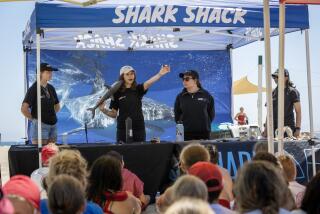LA HABRA : Student to Present Data on Sharks
- Share via
A La Habra high school senior who studied the effect of exercise on shark muscles is one of 65 students chosen nationwide to present research papers at a science conference in Boston.
Christopher Terrell, 17, studied leopard sharks at a Cal State Fullerton laboratory during the 1991-92 school year. “I got in there and did what scientists actually get to do,” he said.
For eight months of Friday afternoons, Terrell cut up shark muscles, weighed them, and analyzed their chemical contents. He and a graduate student were advised by Kathryn Dickson, a biology professor at Fullerton.
At the science conference, which begins Wednesday, Terrell will lecture about his project and explain it one-on-one at a science fair.
Heavy exercise in sharks, as in humans, produces acids in the muscles that must be neutralized. Terrell wanted to find out if regular exercise produced more of the neutralizing chemicals. It didn’t.
“I enjoy lab work,” he said recently, as he stood next to an electronic scale at the laboratory. “I know that it’s not always going to be the most exciting, but what I did nobody had done before. That was exciting.”
The two-foot-long sharks were exercised in San Diego, then killed, frozen, and sent to Fullerton. “I never messed with the live sharks,” Terrell said. He analyzed samples from three shark groups: eight killed when they were caught; eight left to swim in tanks; and eight exercised vigorously.
Dickson and Terrell will do another experiment this spring to see if they can find out why the heavily exercised sharks did not produce more neutralizing chemicals.
Terrell’s biology teacher, Gloria Takahashi, recruited him for the Young Scholars program, which connects university scientists and high school students. “These kids are some of the brightest and most outstanding kids in science,” Takahashi said. Another Young Scholar was a guest at President Clinton’s inauguration, she said.
Takahashi started a program in 1980 that placed science students with professors for research. Then, in 1989, she wrote a grant to receive money for the Young Scholars program.
Now she oversees about 70 students in Southern California. The college-level program is a blessing for high school science teachers, she said. “There’s no time built into our schedule, and there’s no money to allow students to do individualized work.”
Takahashi also encouraged Terrell’s sister Marjorie, 16, to join the program. She is now studying the eating habits of turkey vultures.
In addition to his fascination with science, Terrell likes to play drums and runs the 800 meters for his high school team. He also plays alto sax, tuba and baritone horn in the marching band.
Terrell said he wants to study English in college and then become a doctor.
“I was very impressed with the fact that he has all these interests and was able to juggle them,” Dickson said of Terrell.
Terrell’s mother, Mary Avilez-Dunn, said he has always been busy learning about new things. Sometimes too busy. “One time I told Christopher he had to stay home and play video games,” she said, laughing. Avilez-Dunn and Takahashi will travel with Terrell to Boston.
Terrell’s parents both work in education. His mother teaches fourth-graders at a bilingual school in Los Angeles County. His father, Emmett Terrell, is an assistant superintendent in Pomona.
More to Read
Sign up for Essential California
The most important California stories and recommendations in your inbox every morning.
You may occasionally receive promotional content from the Los Angeles Times.













